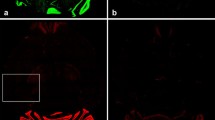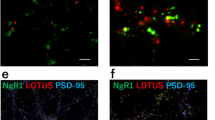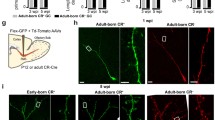Abstract
Glutamate is an excitatory neurotransmitter in the olfactory system and its N-methyl-d-aspartate-(NMDA) receptor subunits [GluN1 (NR1), GluN2A (NR2A), and GluN2B (NR2B)] are expressed at synapses in the olfactory bulb and olfactory epithelium. Thus, glutamatergic neurons and NMDA receptors play key roles in olfaction. GluN3A (NR3A) is a unique inhibitory subunit in the NMDA receptor complex; however, the expression and functional role of GluN3A in the olfactory bulb and epithelium remain unclear. The present study examined the expression patterns of GluN3A in the olfactory bulb and epithelium and explored its functional role in the olfactory system. Immunohistochemical and Western blot analyses revealed that GluN3A is abundantly expressed in different cellular layers of the olfactory bulb and epithelium of the adult wild type (WT) mice. In littermate GluN3A knockout (GluN3A−/−; KO) mice, the expression of olfactory marker protein normally found in mature olfactory sensory neurons was significantly reduced in the olfactory bulb and epithelium. A butyl alcohol stimulus increased immediate-early gene c-Fos expression in the olfactory system of WT mice, while this response was absent in GluN3A KO mice. The level of phosphorylated Ca2+/calmodulin-dependent kinase II was significantly lower in GluN3A KO mice compared to WT mice. In buried food finding test, GluN3A mice took significantly longer time to find food compared to WT mice. Consistently, impaired odor distinguishing ability was seen in GluN3A KO mice. These findings suggest that GluN3A, expressed in the adult olfactory system, plays a significant regulatory role in olfactory development and functional activity.








Similar content being viewed by others
Abbreviations
- NMDA:
-
N-methyl-d-aspartate
- NMDAR:
-
NMDA receptor
- WT:
-
Wild-type
- KO:
-
Knockout
- GluN1:
-
Glutamate NMDA receptor 1 (NR1)
- GluN2:
-
Glutamate NMDA receptor 2A (NR2A)
- GluN2B:
-
Glutamate NMDA receptor 2B (NR2B)
- GluN3A:
-
Glutamate NMDA receptor 3A (NR3A)
- GluN3B:
-
Glutamate NMDA receptor 3B (NR3B)
- OMP:
-
Olfactory marker protein
- ONL:
-
Olfactory nerve layer
- GCL:
-
Granular cell layer
- MCL:
-
Mitral cell layer
- EPL:
-
External plexiform layer
- GL:
-
Glomerular layer
- CaMKII:
-
Ca2+/calmodulin-dependent kinase II
- CREB:
-
CAMP response element-binding protein
References
Al-Hallaq RA, Jarabek BR, Fu Z, Vicini S, Wolfe BB, Yasuda RP (2002) Association of NR3A with the N-methyl-d-aspartate receptor NR1 and NR2 subunits. Mol Pharmacol 62(5):1119–1127
Baldisseri DM, Margolis JW, Weber DJ, Koo JH, Margolis FL (2002) Olfactory marker protein (OMP) exhibits a beta-clam fold in solution: implications for target peptide interaction and olfactory signal transduction. J Mol Biol 319(3):823–837. doi:10.1016/S0022-2836(02)00282-6
Bieri S, Monastyrskaia K, Schilling B (2004) Olfactory receptor neuron profiling using sandalwood odorants. Chem Senses 29(6):483–487. doi:10.1093/chemse/bjh050
Bliss TV, Collingridge GL (1993) A synaptic model of memory: long-term potentiation in the hippocampus. Nature 361(6407):31–39. doi:10.1038/361031a0
Buiakova OI, Baker H, Scott JW, Farbman A, Kream R, Grillo M, Franzen L, Richman M, Davis LM, Abbondanzo S, Stewart CL, Margolis FL (1996) Olfactory marker protein (OMP) gene deletion causes altered physiological activity of olfactory sensory neurons. Proc Natl Acad Sci USA 93(18):9858–9863
Chaudhury D, Manella L, Arellanos A, Escanilla O, Cleland TA, Linster C (2010) Olfactory bulb habituation to odor stimuli. Behav Neurosci 124(4):490–499. doi:10.1037/a0020293
Chen WR, Xiong W, Shepherd GM (2000) Analysis of relations between NMDA receptors and GABA release at olfactory bulb reciprocal synapses. Neuron 25(3):625–633. pii S0896-6273(00)81065-X
Choi DW (1992) Excitotoxic cell death. J Neurobiol 23(9):1261–1276. doi:10.1002/neu.480230915
Ciabarra AM, Sullivan JM, Gahn LG, Pecht G, Heinemann S, Sevarino KA (1995) Cloning and characterization of chi-1: a developmentally regulated member of a novel class of the ionotropic glutamate receptor family. J Neurosci 15(10):6498–6508
Cull-Candy S, Brickley S, Farrant M (2001) NMDA receptor subunits: diversity, development and disease. Curr Opin Neurobiol 11(3):327–335
Danciger E, Mettling C, Vidal M, Morris R, Margolis F (1989) Olfactory marker protein gene: its structure and olfactory neuron-specific expression in transgenic mice. Proc Natl Acad Sci USA 86(21):8565–8569
Das S, Sasaki YF, Rothe T, Premkumar LS, Takasu M, Crandall JE, Dikkes P, Conner DA, Rayudu PV, Cheung W, Chen HS, Lipton SA, Nakanishi N (1998) Increased NMDA current and spine density in mice lacking the NMDA receptor subunit NR3A. Nature 393(6683):377–381. doi:10.1038/30748
Dingledine R, Borges K, Bowie D, Traynelis SF (1999) The glutamate receptor ion channels. Pharmacol Rev 51(1):7–61
Dragunow M, Faull R (1989) The use of c-fos as a metabolic marker in neuronal pathway tracing. J Neurosci Met 29(3):261–265
Fan J, Ngai J (2001) Onset of odorant receptor gene expression during olfactory sensory neuron regeneration. Dev Biol 229(1):119–127. doi:10.1006/dbio.2000.9972
Firestein S (2001) How the olfactory system makes sense of scents. Nature 413(6852):211–218. doi:10.1038/35093026
Guthrie KM, Anderson AJ, Leon M, Gall C (1993) Odor-induced increases in c-fos mRNA expression reveal an anatomical “unit” for odor processing in olfactory bulb. Proc Natl Acad Sci USA 90(8):3329–3333
Halabisky B, Friedman D, Radojicic M, Strowbridge BW (2000) Calcium influx through NMDA receptors directly evokes GABA release in olfactory bulb granule cells. J Neurosci 20(13):5124–5134. pii 20/13/5124
Henson MA, Larsen RS, Lawson SN, Perez-Otano I, Nakanishi N, Lipton SA, Philpot BD (2012) Genetic deletion of NR3A accelerates glutamatergic synapse maturation. PLoS One 7(8):e42327. doi:10.1371/journal.pone.0042327
Herdegen T, Leah JD (1998) Inducible and constitutive transcription factors in the mammalian nervous system: control of gene expression by Jun, Fos and Krox, and CREB/ATF proteins. Brain Res Brain Res Rev 28(3):370–490
Hoffman GE, Smith MS, Verbalis JG (1993) c-Fos and related immediate early gene products as markers of activity in neuroendocrine systems. Front Neuroendocrinol 14(3):173–213. doi:10.1006/frne.1993.1006
Hollmann M, Heinemann S (1994) Cloned glutamate receptors. Annu Rev Neurosci 17:31–108. doi:10.1146/annurev.ne.17.030194.000335
Isaacson JS (2001) Mechanisms governing dendritic gamma-aminobutyric acid (GABA) release in the rat olfactory bulb. Proc Natl Acad Sci USA 98(1):337–342. doi:10.1073/pnas.021445798
Isaacson JS, Strowbridge BW (1998) Olfactory reciprocal synapses: dendritic signaling in the CNS. Neuron 20(4):749–761. pii S0896-6273(00)81013-2
Jamain S, Radyushkin K, Hammerschmidt K, Granon S, Boretius S, Varoqueaux F, Ramanantsoa N, Gallego J, Ronnenberg A, Winter D, Frahm J, Fischer J, Bourgeron T, Ehrenreich H, Brose N (2008) Reduced social interaction and ultrasonic communication in a mouse model of monogenic heritable autism. Proc Natl Acad Sci USA 105(5):1710–1715. doi:10.1073/pnas.0711555105
Kim JW, Hong SL, Lee CH, Jeon EH, Choi AR (2010) Relationship between olfactory function and olfactory neuronal population in C57BL6 mice injected intraperitoneally with 3-methylindole. Otolaryngol Head Neck Surg 143(6):837–842. doi:10.1016/j.otohns.2010.08.016
Larsen RS, Corlew RJ, Henson MA, Roberts AC, Mishina M, Watanabe M, Lipton SA, Nakanishi N, Perez-Otano I, Weinberg RJ, Philpot BD (2011) NR3A-containing NMDARs promote neurotransmitter release and spike timing-dependent plasticity. Nat Neurosci 14(3):338–344. doi:10.1038/nn.2750
Laurie DJ, Seeburg PH (1994) Regional and developmental heterogeneity in splicing of the rat brain NMDAR1 mRNA. J Neurosci 14(5 Pt 2):3180–3194
Lee AC, He J, Ma M (2011) Olfactory marker protein is critical for functional maturation of olfactory sensory neurons and development of mother preference. J Neurosci 31(8):2974–2982. doi:10.1523/JNEUROSCI.5067-10.2011
Lee J, Gu X, Wei L, Wei Z, Dix TA, Yu SP (2014) Therapeutic effects of pharmacologically induced hypothermia against traumatic brain injury in mice. J Neurotrauma. doi:10.1089/neu.2013.3251
Lee JH, Wei ZZ, Chen D, Gu X, Wei L, Yu SP (2015) A neuroprotective role of the NMDA receptor subunit GluN3A (NR3A) in ischemic stroke of the adult mouse. Am J Physiol Cell Physiol 308(7):C570–C577. doi:10.1152/ajpcell.00353.2014
Leinders-Zufall T, Ma M, Zufall F (1999) Impaired odor adaptation in olfactory receptor neurons after inhibition of Ca2+/calmodulin kinase II. J Neurosci 19(14):RC19
Lethbridge R, Hou Q, Harley CW, Yuan Q (2012) Olfactory bulb glomerular NMDA receptors mediate olfactory nerve potentiation and odor preference learning in the neonate rat. PLoS One 7(4):e35024. doi:10.1371/journal.pone.0035024
Margot C (2009) A noseful of objects. Nat Neurosci 12(7):813–814. doi:10.1038/nn0709-813
McBain CJ, Mayer ML (1994) N-methyl-d-aspartic acid receptor structure and function. Physiol Rev 74(3):723–760
Meldrum BS (2000) Glutamate as a neurotransmitter in the brain: review of physiology and pathology. J Nutr 130(4S Suppl):1007S–1015S
Mohamad O, Song M, Wei L, Yu SP (2013) Regulatory roles of the NMDA receptor GluN3A subunit in locomotion, pain perception and cognitive functions in adult mice. J Physiol 591(Pt 1):149–168. doi:10.1113/jphysiol.2012.239251
Monyer H, Sprengel R, Schoepfer R, Herb A, Higuchi M, Lomeli H, Burnashev N, Sakmann B, Seeburg PH (1992) Heteromeric NMDA receptors: molecular and functional distinction of subtypes. Science 256(5060):1217–1221
Neant-Fery M, Peres E, Nasrallah C, Kessner M, Gribaudo S, Greer C, Didier A, Trembleau A, Caille I (2012) A role for dendritic translation of CaMKIIalpha mRNA in olfactory plasticity. PLoS One 7(6):e40133. doi:10.1371/journal.pone.0040133
Norlin EM, Vedin V, Bohm S, Berghard A (2005) Odorant-dependent, spatially restricted induction of c-fos in the olfactory epithelium of the mouse. J Neurochem 93(6):1594–1602. doi:10.1111/j.1471-4159.2005.03159.x
Pabba M, Hristova E, Biscaro D (2012) The elusive roles of NMDA receptor amino-terminal domains. J Physiol 590(Pt 22):5561–5562. doi:10.1113/jphysiol.2012.243311
Perez-Otano I, Schulteis CT, Contractor A, Lipton SA, Trimmer JS, Sucher NJ, Heinemann SF (2001) Assembly with the NR1 subunit is required for surface expression of NR3A-containing NMDA receptors. J Neurosci 21(4):1228–1237
Roberts AC, Diez-Garcia J, Rodriguiz RM, Lopez IP, Lujan R, Martinez-Turrillas R, Pico E, Henson MA, Bernardo DR, Jarrett TM, Clendeninn DJ, Lopez-Mascaraque L, Feng G, Lo DC, Wesseling JF, Wetsel WC, Philpot BD, Perez-Otano I (2009) Downregulation of NR3A-containing NMDARs is required for synapse maturation and memory consolidation. Neuron 63(3):342–356. doi:10.1016/j.neuron.2009.06.016
Schoppa NE, Kinzie JM, Sahara Y, Segerson TP, Westbrook GL (1998) Dendrodendritic inhibition in the olfactory bulb is driven by NMDA receptors. J Neurosci 18(17):6790–6802
Shepherd GM (2004) The synaptic organization of the brain, 5th edn. Oxford University Press, Oxford, New York
Smith PC, Firestein S, Hunt JF (2002) The crystal structure of the olfactory marker protein at 2.3 A resolution. J Mol Biol 319(3):807–821. doi:10.1016/S0022-2836(02)00242-5
Steele AD, Jackson WS, King OD, Lindquist S (2007) The power of automated high-resolution behavior analysis revealed by its application to mouse models of Huntington’s and prion diseases. Proc Natl Acad Sci USA 104(6):1983–1988. doi:10.1073/pnas.0610779104
Sucher NJ, Akbarian S, Chi CL, Leclerc CL, Awobuluyi M, Deitcher DL, Wu MK, Yuan JP, Jones EG, Lipton SA (1995) Developmental and regional expression pattern of a novel NMDA receptor-like subunit (NMDAR-L) in the rodent brain. J Neurosci 15(10):6509–6520
Watt WC, Sakano H, Lee ZY, Reusch JE, Trinh K, Storm DR (2004) Odorant stimulation enhances survival of olfactory sensory neurons via MAPK and CREB. Neuron 41(6):955–967
Wei J, Zhao AZ, Chan GC, Baker LP, Impey S, Beavo JA, Storm DR (1998) Phosphorylation and inhibition of olfactory adenylyl cyclase by CaM kinase II in Neurons: a mechanism for attenuation of olfactory signals. Neuron 21(3):495–504
Wesson DW, Donahou TN, Johnson MO, Wachowiak M (2008) Sniffing behavior of mice during performance in odor-guided tasks. Chem Senses 33(7):581–596. doi:10.1093/chemse/bjn029
Witt RM, Galligan MM, Despinoy JR, Segal R (2009) Olfactory behavioral testing in the adult mouse. J Vis Exp 23:e949. doi:10.3791/949
Wong HK, Liu XB, Matos MF, Chan SF, Perez-Otano I, Boysen M, Cui J, Nakanishi N, Trimmer JS, Jones EG, Lipton SA, Sucher NJ (2002) Temporal and regional expression of NMDA receptor subunit NR3A in the mammalian brain. J Comp Neurol 450(4):303–317. doi:10.1002/cne.10314
Yang M, Crawley JN (2009) Simple behavioral assessment of mouse olfaction. Curr Protoc Neurosci Chapter 8:Unit 8 24. doi:10.1002/0471142301.ns0824s48
Youngentob SL, Mozell MM, Sheehe PR, Hornung DE (1987) A quantitative analysis of sniffing strategies in rats performing odor detection tasks. Physiol Behav 41(1):59–69
Youngentob SL, Kent PF, Margolis FL (2003) OMP gene deletion results in an alteration in odorant-induced mucosal activity patterns. J Neurophysiol 90(6):3864–3873. doi:10.1152/jn.00806.2002
Zou DJ, Greer CA, Firestein S (2002) Expression pattern of alpha CaMKII in the mouse main olfactory bulb. J Comp Neurol 443(3):226–236
Zufall F, Leinders-Zufall T (2000) The cellular and molecular basis of odor adaptation. Chem Senses 25(4):473–481
Acknowledgments
This work was supported by the NIH grants NS0458710 (SPY), NS075338 (LW), NS062097 (LW), NS073378 (TAD and SPY), and the American Heart Association grant AHA 12GRNT12060222 (SPY) and the AHA Established Investigator Award (LW).
Author information
Authors and Affiliations
Corresponding author
Ethics declarations
Conflict of interest
None.
Research involving Human Participants and/or Animals
No human participants involved. All animal experiments and experimental protocols were approved by the Emory University Institutional Animal Care and Use Committee (IACUC) and were in compliance with National Institutes of Health (NIH) guidelines.
Rights and permissions
About this article
Cite this article
Lee, J.H., Wei, L., Deveau, T.C. et al. Expression of the NMDA receptor subunit GluN3A (NR3A) in the olfactory system and its regulatory role on olfaction in the adult mouse. Brain Struct Funct 221, 3259–3273 (2016). https://doi.org/10.1007/s00429-015-1099-3
Received:
Accepted:
Published:
Issue Date:
DOI: https://doi.org/10.1007/s00429-015-1099-3




